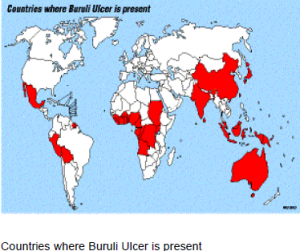David R. Nielsen and Dr. Warner Woodworth, Business Management
First discovered in 1947 in a small community in Australia, the Buruli Ulcer (Mycobacterium Ulcerans) has become the third largest mycobacterial disease in the world, next to leprosy and tuberculosis. Dobos et al. estimate that the severity of the Buruli Ulcer will soon reach that of leprosy. In a 10-year study conducted in Ivory Coast, villages were surveyed to assess the degree of infection. In some communities, the rate was shown to be as high as 16%, with current estimates as high as 22%.
The Buruli Ulcer is most common in West Africa, especially in Ghana. For four years, HART (Humanitarian Aid Relief Team) has traveled to Ghana with teams of surgeons, nurses, and other volunteers to treat victims of the Buruli Ulcer by performing skin grafts on the most severe cases and by excising the small nodules at their early stages. Also, HART volunteers have traveled to small communities to teach villagers about the disease so that it can be easily recognized and treated.
After traveling to Ghana with HART, I was able to witness first-hand the terrible effects of the Buruli Ulcer. People came to the hospital with terrible ulcers on their hands, limbs, and torso. Without any kind of skin graft, the ulcer remains and continues to enlarge until it covers enormous areas of the body. Skin grafts continue to be the most effective form of treatment—allowing the ulcer to heal and restoring use of the affected limb. Presently, no antibiotic exists that works against the toxin; however, several antibiotics are being tested.
The mycobacterium that causes Buruli Ulcer has been isolated; however, the exact mechanism by which the bacterium results in necrosis of the tissue is unknown. Some studies suggest that the mycobacterium ulcerans may have some immunosuppressive qualities that contribute to the overall destruction of the tissue. Researchers have performed epidemiological studies and have determined that the disease is highly concentrated in regions of tropical wetlands. Many cases of Buruli Ulcer have been predisposed to minor skin abrasions which contribute to the entry of the bacterium. The mycobacterium grows fastest between the temperatures of 30 and 33 degrees Celsius and in areas rich in fatty acids.
In March, the World Health Organization held a conference in Geneva, Switzerland in which HART was invited to participate. Several prominent investigators on the Buruli Ulcer were present, and HART made several ties to those working towards the eradication of the disease. Presently, the disease is found in many countries throughout the world including Ghana, Ivory Coast, Nigeria, China, India, Indonesia, Mexico, Peru, and Australia, among others.
HART continues to provide assistance to those suffering from the Buruli Ulcer. Our organization is looking forward to completing projects within the next year. I anticipate returning to Ghana again to assess the extent to which the disease has developed in some of the districts where we have been rendering our services.
My efforts towards the eradication of this disease have involved significant amounts of fund-raising. As the fundraising director for HART, I have sought to raise funds to assist in the immediate care and awareness of this terrible disease. In the October 1998, I organized a fund-raising concert at the University of Utah’s Kingsbury Hall which raised about $8,000. In addition to the concert, I sent out proposal and packets to companies in Utah requesting their assistance. Several companies responded including NuSkin, FranklinCovey, IHC, and O.C. Tanner. The donations from these companies resulted in over 26,000 dollars. Within just four months, I was able to raise more than 30,000 for HART. NuSkin International has made HART one their “Force for Good Foundation” projects, and they are continuing to sponsor future trips.
HART is planning trips to Ghana at the end of this year and in the spring. I look forward to returning and continuing the valuable work that HART has begun. I am currently in the process of recruiting physicians, nurses, and volunteers to participate in these upcoming trips. Hopefully, through our efforts, we can make a difference and contribute to the eradication of this disease.
References
- Dobos, Karen M. et al. “Emergence of a Unique Group of Necrotizing Mycobacterial Diseases,” Emerging Infectious Diseases, 5(3), 1999.
- World Health Organization web site: www.who.int/gtb-buruli/index/html

